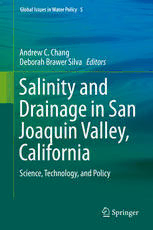
Salinity and Drainage in San Joaquin Valley, California: Science, Technology, and Policy PDF
Preview Salinity and Drainage in San Joaquin Valley, California: Science, Technology, and Policy
Global Issues in Water Policy 5 Andrew C. Chang Deborah Brawer Silva Editors Salinity and Drainage in San Joaquin Valley, California Science, Technology, and Policy Salinity and Drainage in San Joaquin Valley, California GLOBAL ISSUES IN WATER POLICY VOLUME 5 Editor-in-chief Ariel Dinar Series Editors Jose´ Albiac Eric D. Mungatana V´ıctor Pochat Rathinasamy Maria Saleth For furthervolumes: http://www.springer.com/series/8877 Andrew C. Chang (cid:129) Deborah Brawer Silva Editors Salinity and Drainage in San Joaquin Valley, California Science, Technology, and Policy Editors AndrewC.Chang DeborahBrawerSilva UniversityofCalifornia UniversityofCalifornia CenterforWaterResources CenterforWaterResources Riverside,CA,USA Riverside,CA,USA ISSN2211-0631 ISSN2211-0658(electronic) ISBN978-94-007-6850-5 ISBN978-94-007-6851-2(eBook) DOI10.1007/978-94-007-6851-2 SpringerDordrechtHeidelbergNewYorkLondon ©SpringerScience+BusinessMediaDordrecht2014 Thisworkissubjecttocopyright.AllrightsarereservedbythePublisher,whetherthewholeorpart of the material is concerned, specifically the rights of translation, reprinting, reuse of illustrations, recitation,broadcasting,reproductiononmicrofilmsorinanyotherphysicalway,andtransmissionor informationstorageandretrieval,electronicadaptation,computersoftware,orbysimilarordissimilar methodologynowknownorhereafterdeveloped.Exemptedfromthislegalreservationarebriefexcerpts inconnectionwithreviewsorscholarlyanalysisormaterialsuppliedspecificallyforthepurposeofbeing enteredandexecutedonacomputersystem,forexclusiveusebythepurchaserofthework.Duplication ofthispublicationorpartsthereofispermittedonlyundertheprovisionsoftheCopyrightLawofthe Publisher’s location, in its current version, and permission for use must always be obtained from Springer.PermissionsforusemaybeobtainedthroughRightsLinkattheCopyrightClearanceCenter. ViolationsareliabletoprosecutionundertherespectiveCopyrightLaw. The use of general descriptive names, registered names, trademarks, service marks, etc. in this publicationdoesnotimply,evenintheabsenceofaspecificstatement,thatsuchnamesareexempt fromtherelevantprotectivelawsandregulationsandthereforefreeforgeneraluse. While the advice and information in this book are believed to be true and accurate at the date of publication,neithertheauthorsnortheeditorsnorthepublishercanacceptanylegalresponsibilityfor anyerrorsoromissionsthatmaybemade.Thepublishermakesnowarranty,expressorimplied,with respecttothematerialcontainedherein. Printedonacid-freepaper SpringerispartofSpringerScience+BusinessMedia(www.springer.com) Kenneth K. Tanji University of California, Davis, California 1931–2007 Preface Salinity and drainage are challenges of irrigated agriculture in semiarid and arid climatesthattranscendhistoryandgeography.ThreethousandyearsbeforeChrist, theMesopotamiacultureemergedandprospered,aidedbydomesticationofcrops andanimalsandemploymentofawaterconveyanceandirrigationnetwork.When thecivilizationcrumbledmillennialater,itwasbroad-spectrumsocio-economical turmoil,poorgovernance,andinstitutionalweaknessthatledtosocietaldeclineand eventually resulted in dilapidated water delivery infrastructure, rising shallow groundwater tables, salinization of soils, and crop failures. When and wherever irrigatedagriculturehasascendedinhistory,thepopulacesoonerorlaterhasbeen forced to cope with the threat of soil salinization. Examples today include Egypt, Jordan,China,Peru,India,Pakistan,Australia,andCalifornia.Whilewatermove- ment,saltbuildupinsoils,andplantinjuriesaremolecular-scaleprocessesgoverned bythenaturallaws,overtime,ithasbeenfailuresinpublicpolicy,institutions,and management,whichhaveculminatedinwholesalecrisesinirrigatedagriculture. Atdifferenttemporalandspatialscales,salinityanddrainageissueswouldtake distinctively different forms and shapes. In 1983, the reproductive failures and deformed embryos of shore birds appeared at the Kesterson National Wildlife Refuge, a wetland fed by subsurface tile drain effluents from farmlands in the westernSanJoaquinValley.Aloomingecologicalcatastrophecausedbyirrigated agriculturewasunfolding.Attheprocesslevel,asdrainagewaterscongregatedin theterminuswaterbody,micro-quantitiesofwaterborneseleniumbio-accumulated unnoticed through the aquatic food chain and quickly reached levels toxic to biota occupying the top ecological echelon. Instantaneously, the ecosystem harm broughtthesustainabilityofirrigatedagricultureintheValleyintoquestion,acrisis attheregionallevel.Basin-wideoptionstoaddresstheissueswereconstrainedby water rights, special interests, public policies and legal mandates, and political actionsatthelocal,statewide,andfederallevels.Onfarms,ifirrigatedagriculture were to continue, the irrigation and cultivation practices had to be adjusted to contain and/or eliminate the release of selenium via drainage water discharge. There were technology gaps to be closed. “How to fix it?” was a multifaceted dilemma. vii viii Preface In 1985, the University of California (UC), Division of Agriculture and Natural Resources,inresponsetotheenvironmentalcrises,launchedtheUCSalinityDrain- ageResearchProgram,mobilizingresourcesandpersonnelforaconcertedeffortto tackleproblemsassociatedwithsalinity,selenium,anddrainageinthewesternSan JoaquinValley.UCresearchersinitiatedadiverserangeofresearchstudies,worked withlocalspecialservicedistricts,andparticipatedininter-agencyreviewpanels.It wasaperiodoffocusedacademicpursuitsbystudentsandfacultyalikeandintense interactions with public agencies, water management professionals, and individual growers. Research findings were disseminated in presentations at workshops and conferences, in written reports distributed among concerned public agencies, in proposals and plans for feasibility assessments, and in technical articles in profes- sional journals. It was the first time salinity drainage problems of an irrigated crop productionregionweresystematicallyandcomprehensivelyinvestigated. The UC Center for Water Resources asked selected participants inthe Salinity DrainageResearchProgramtocriticallyrecapturefindingsthatoverthetimespan of two-plus decades had been scattered in the scientific literature of diverse disciplines. Asthe subject matter isrevisited andupdated, we allbenefitfrom the perspectiveoftimeandexperience,additionalresearchfindings,newtechnologies, andgreaterknowledgebase,toviewthematerialwithwisdom. This compendium of 15 chapters is a collection of independent treatises, each depicting a distinctive salinity drainage topic with fresh perspective. As environ- mentalscientists,engineers,andbiologists,wearecognizantofthemultiplescales at which complex issues should be examined, and we recognize the need to integrate those scales to recommend viable solutions. At first, the subject matter coveredinthiscollectionmayappearrandomandlackinginrelationship,butwhen thescalesareinvokedandintegrated,thenamosaicofirrigatedagricultureintime andspaceemerges.Thefollowingaresynopsesofthechapters: Time, Geography, and Scale Chapter1providesbackgroundinformationandawaterdistributionmaptofamiliar- ize readers with the San Joaquin Valley, setting a stage for events and issues that developed. Chapter2delineatestheevolutionofirrigatedagricultureintheSanJoaquinValley overthetemporalscale.Waterrightsdoctrines,stateandfederalwaterpolicies,and infrastructurebuildingplayeddecisiverolesinhowwaterwasdistributedandused thenandnow.Processesthatfacilitatedirrigatedagriculturetoblossomalsoledto delays in solving salinity and drainage problems. Later, the constraints were set forthbyfederalmandatesintheCleanWaterActandEndangeredSpeciesActand byeco-toxicologicalcrisesofselenium. Chapter 3 depicts the geochemical and hydrological processes that define the San JoaquinValley,includingthephysics,chemistry,andbiologyattributesthatimpact watermanagementpoliciesandstrategiesintheValley. Preface ix Chapter 4 provides a comprehensive discussion of how scales entered into the salinitydrainageresearchandmanagementintheSanJoaquinValley.Scaling,the tools of integrating data obtained at different scales, is imperative in accurately assessingimpactsattheregionallevel. Biogeochemistry of Selenium Chapter 5 elaborates chemical reactions that transform selenium when irrigation water passes through the soil profile and facilitates its transport to subsurface tile drains. Chapter6explainsthebiochemicalrolesofplantsinabsorbingseleniumfromsoils and transforming and volatilizing it as gaseous methyl selenium. The processes havethepotentialtoreduceandeliminateseleniumfromthedrainagewater. Chapter 7 describes how microbial reductive processes to precipitate selenium species found in the drainage water are affected by environmental factors and demonstratesapathtooptimizethereductionofselenium. Chapter8describesthe aquaticchemistryandbiologyofseleniuminevaporation ponds that are employed to retain and concentrate dissolved salts in the drainage water. Again, the processes may be employed to reduce the selenium load of the drainagewaterstream. Coping with the Salts Chapter9showsthatevaporationponds,whileactingastherepositoryforselenium anddissolvedsaltsinthedrainagewater,mightbeathreattothesafetyofforaging shorebirds.However,providingalternativeandcompensatoryhabitatsforthebirds can mitigate the potential hazards. The evaporationpond systems operated by the TulareLakeDrainageDistrictareasuccessfulexample. Chapter 10 documents on-farm and plot-level irrigation provisions that would reduce agricultural drainage outputs and examines their effects on plant perfor- mance.Thesemeso-scalepracticesmightbeimplementedonabasin-widelevelto enhanceirrigationefficienciesandreducedrainageandsaltdisposalrequirements. Chapter 11 explores the on-farm drainage water reuse potential and tests the integrated farm drainage management (IFDM) approach. Drainage water may be retainedon-farmbycollecting,blending,andreusingitforirrigationofamoresalt- tolerant crop. The secondary drainage water, in turn, may be reused on an even moresalt-tolerantcrop.Thesystem,ifproperlyscaledandoperated,wouldreduce thedrainagevolumeandconcentratethesaltsforfinaldisposal.
